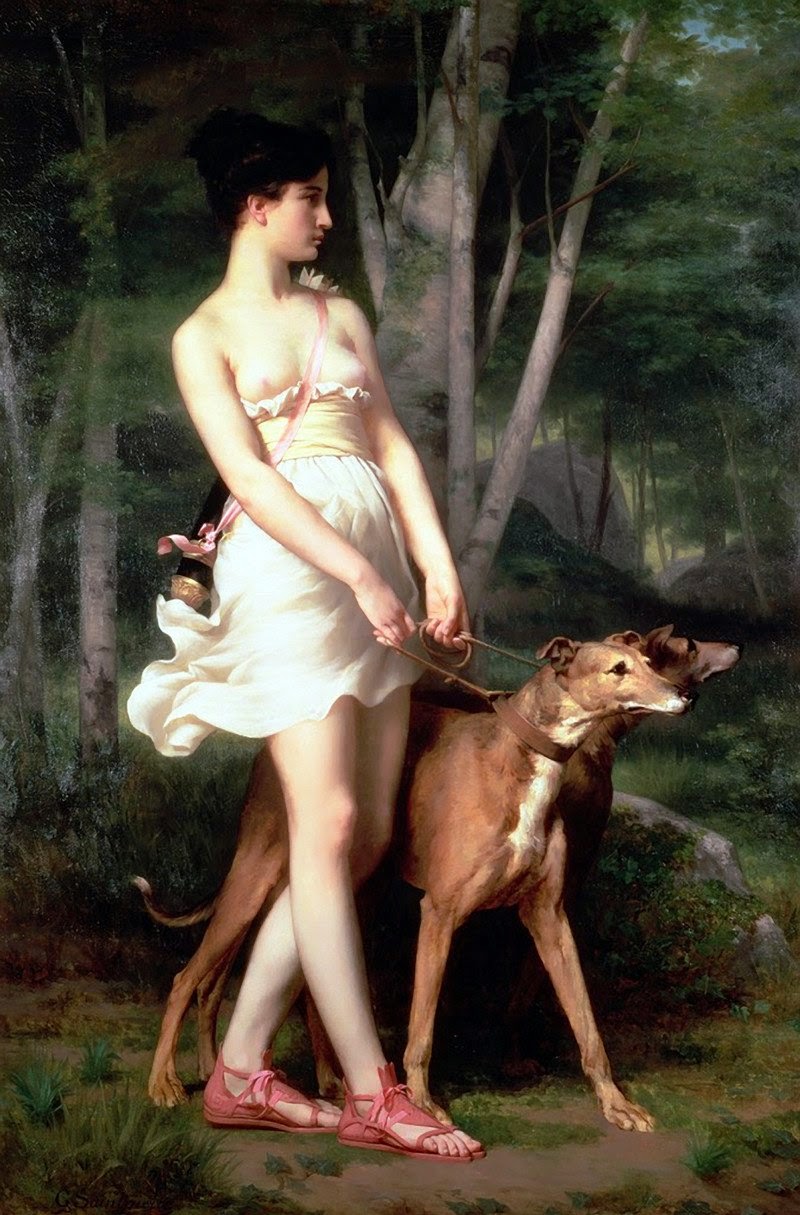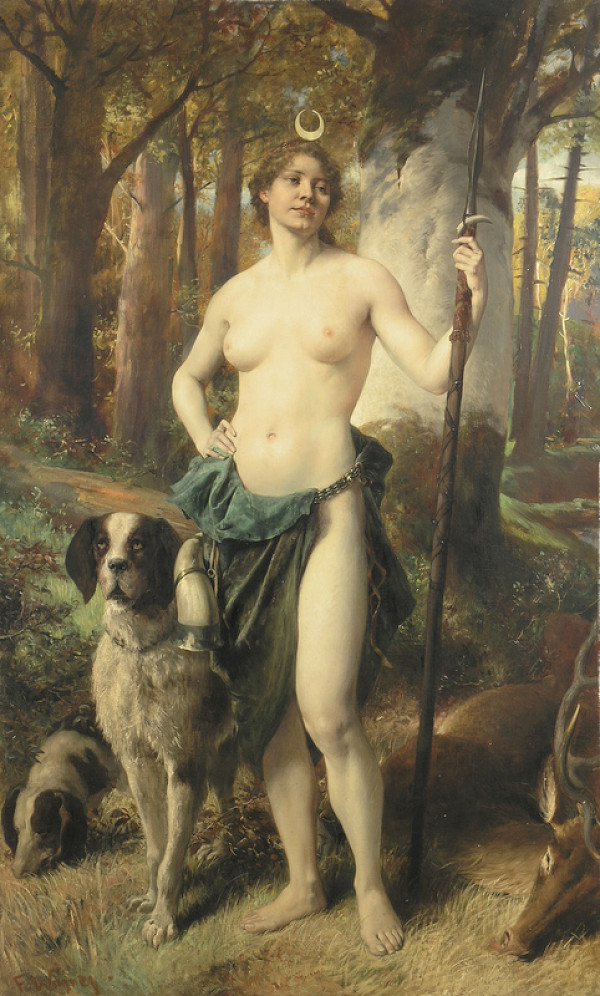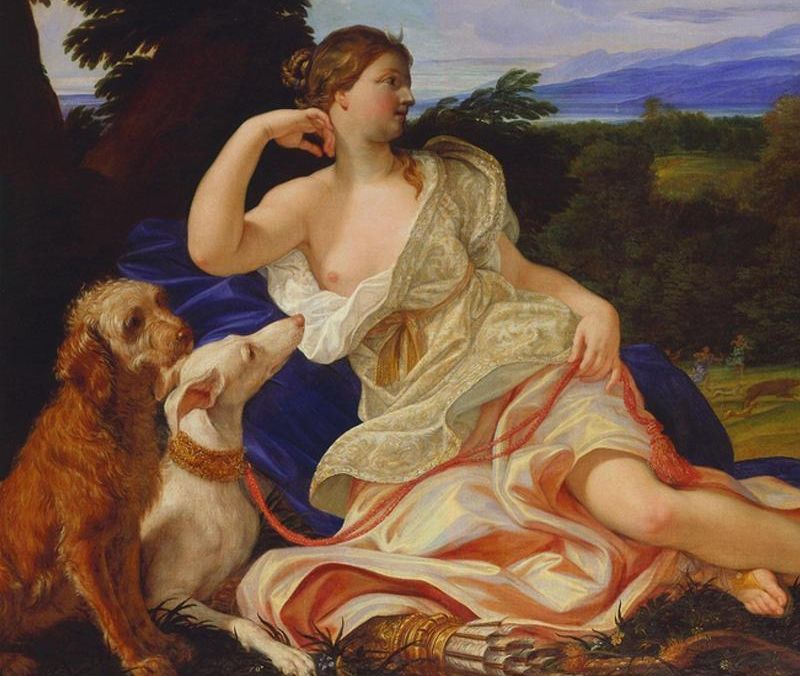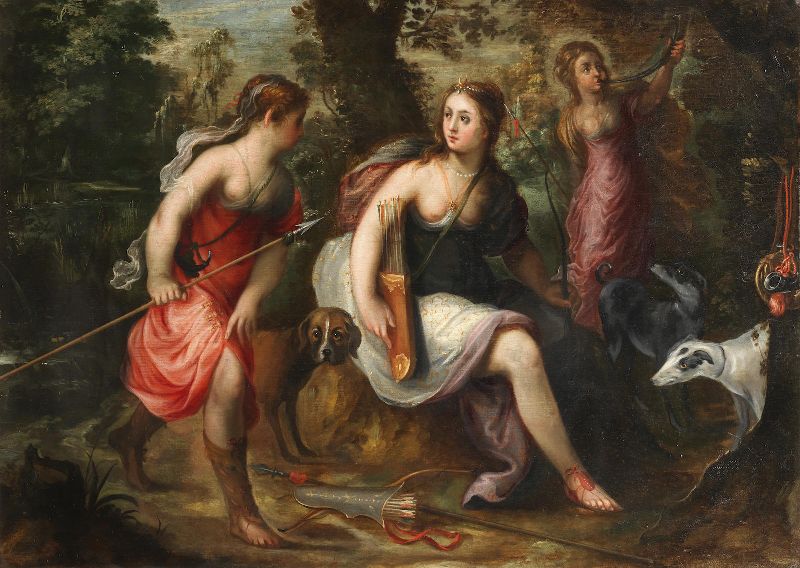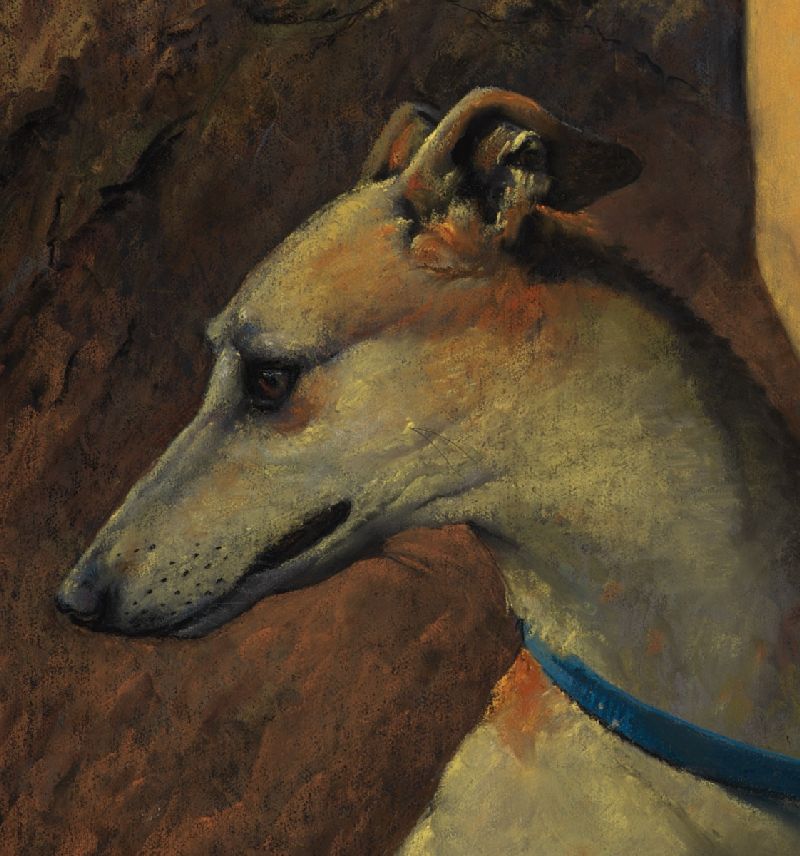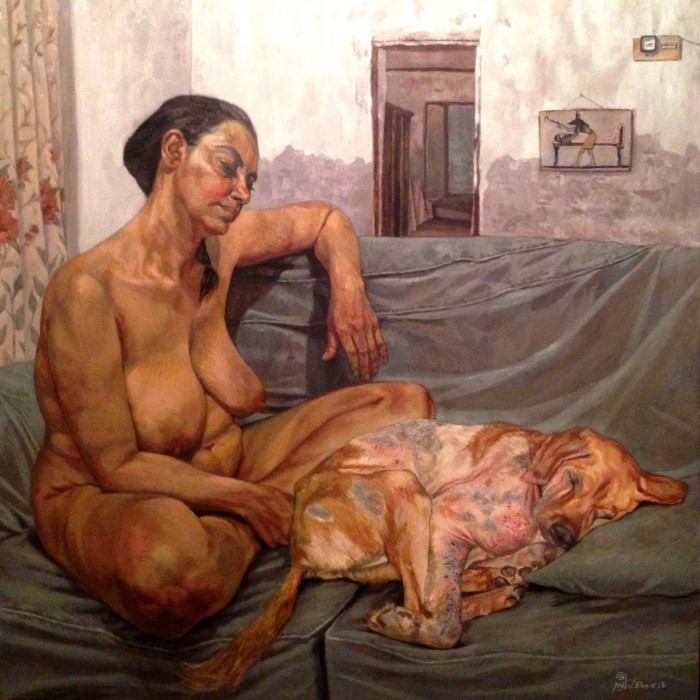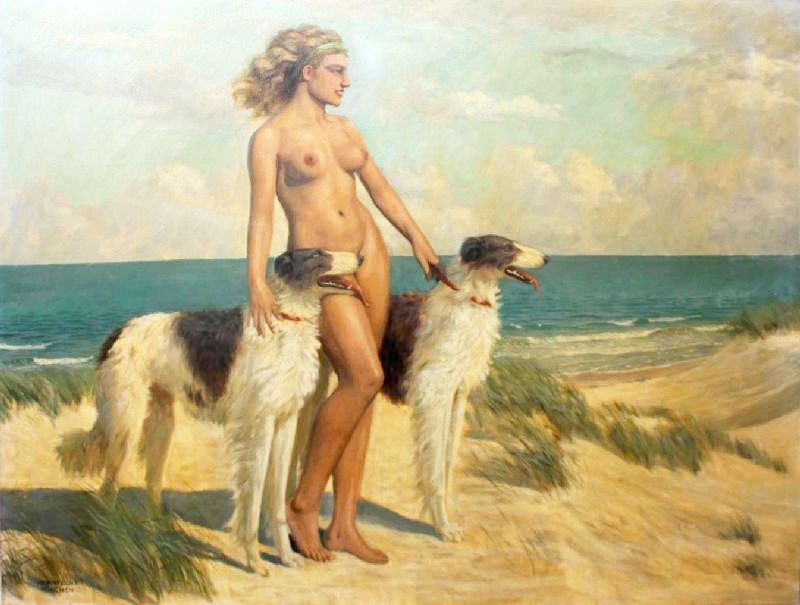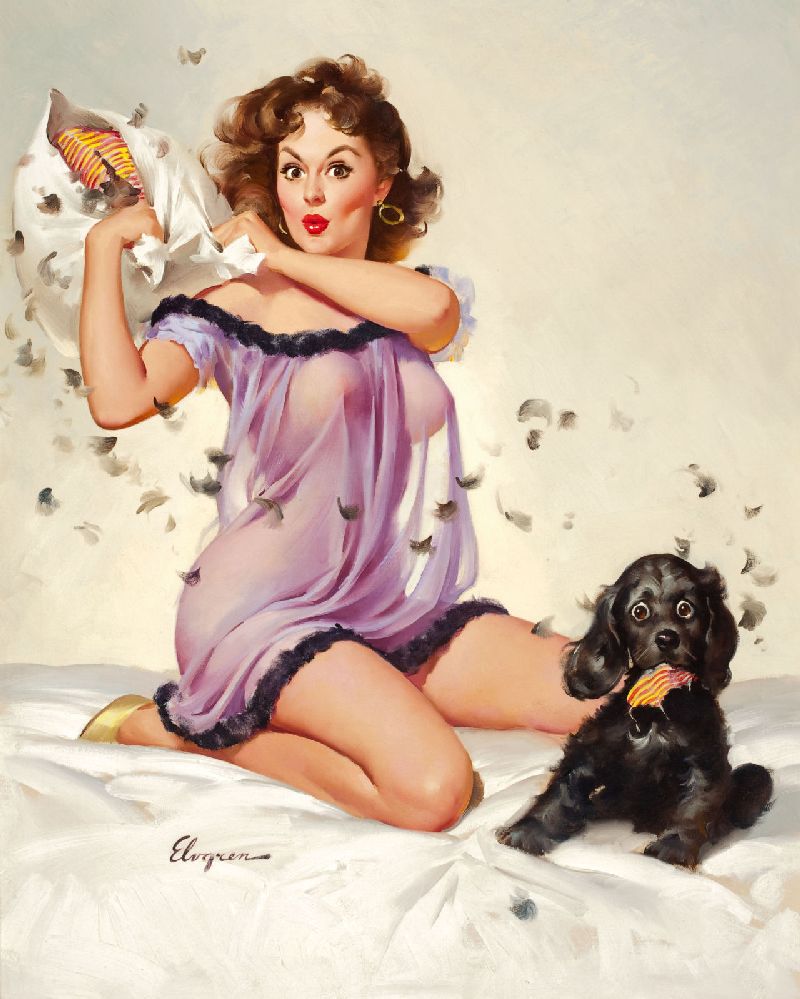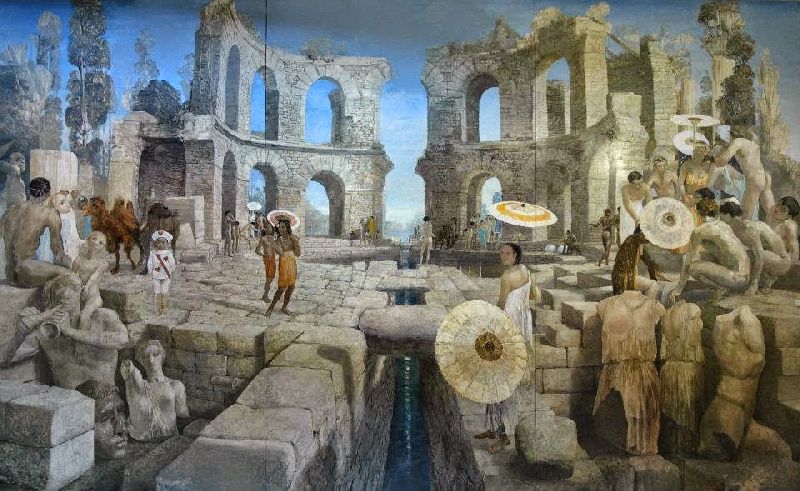Desnudo con perro / Nude With Dog
Tal vez el caso más frecuente de desnudo femenino con perro en la pintura clásica sea la representación de Diana la cazadora. Lo más habitual es verla desnuda, al menos de medio cuerpo, portando un arco y acompañada de un animal, generalmente un perro o un ciervo. Veamos algunos ejemplos.
Perhaps the most frequent case of female nude with dog in classical painting is the representation of Diana the huntress. The most usual is to see her naked, at least half a body, carrying a bow and accompanied by an animal, usually a dog or a deer. Let's see some examples.
__________________________________________
Escuela de Fontainebleau / School of Fontainebleau
"Diane chasseresse / Diana la cazadora / Diana The Huntress"
Óleo sobre lienzo / oil on canvas, 191 x 132 cm., mediados del s.XVI / mid. 16th century
Musée du Louvre (París, Francia / France). Wikimedia Commons
La actitud de esta Diana parece inspirada en una escultura helenística, la Diana con la cierva, de la cual una copia fundida en bronce por Primatice estaba en Fontainebleau en el siglo XVI. La obra es, sin duda, un retrato idealizado de Diane de Poitiers, amante del rey Enrique II.
The attitude of this Diana seems inspired by a helenistic sculpture, the Diana with the doe, of which a copy casted in bronze by Primatice was in Fontainebleau in the XVIth century. The work is undoubtedly an idealized portrait of Diane de Poitiers, mistress of King Henry II.
____________________________________________
Gaston Casimir Saint-Pierre
(Nîmes (Gard), Francia / France, 1833 - París, 1916)
Gaston Casimir Saint-Pierre fue un pintor francés nacido en 1833 en París.
Fue alumno de Léon Cogniet y Charles Jalabert en París. Hizo varios viajes al norte de África y Argel, de donde trae muchos bocetos y dibujos.
En 1900 pintó un lienzo que representa a Marsella para decorar la gran sala del restaurante Le Train bleu en la Gare de Lyon en París.
Creó paneles decorativos para la Catedral del Sagrado Corazón de Orán.
Fue ascendido al rango de Oficial de la Legión de Honor.
Murió en 1916.
"Diana la cazadora / Diana the Huntress"
Óleo sobre lienzo / oil on canvas. Colección privada / Private Collection. Wikimedia Commons
Gaston Casimir Saint-Pierre was a French painter born in 1833 in Paris.
He was a student of Léon Cogniet and Charles Jalabert in Paris. He made several trips to North Africa and Algiers from where he brings many sketches and drawings.
In 1900, he painted a canvas depicting Marseille to decorate the large room of the restaurant Le Train bleu at the Gare de Lyon in Paris.
He created decorative panels for the Cathedral of the Sacred Heart of Oran.
He was promoted to the rank of Officer of the Legion of Honor.
He died in 1916.
____________________________________________
Ferdinand Wagner
(Passau, Alemania / Germany, 1847 - Múnich / München, 1927)
Diana mit ihrem Hund auf einer Waldlichtung / Diana con su perro en el claro de un bosque /
Diana with her dog in the clear of a forest", c.1904. Symbolon
Ferdinand Wagner fue un pintor alemán nacido en 1847 en Passau.
Era el hijo del profesor de la escuela de comercio Passau Ferdinand Wagner senior, que no debe confundirse con el pintor de Munich Ferdinand Wagner. Recibió su primera educación de su padre. Luego estudió en la Academia de Arte de Munich con Peter von Cornelius y Julius Schnorr von Carolsfeld, seguido de una estancia en Italia 1867/68.
Después de su regreso a Alemania, atrajo la atención con la pintura de la antigua taberna de vinos a Tenormayer en Munich. Como resultado, recibió numerosos encargos para pinturas decorativas.
Entre las obras de Wagner destacaron especialmente las pinturas de pared y techo en el Munich Ratskeller y el Deutsches Theater, la decoración del comedor en el castillo del dragón en Königswinter am Rhein, la decoración de los cafés Roth y Luitpold en Munich, y el restaurante Tivoli en Londres. En 1890-91 hizo varias decoraciones para el buque de vapor Príncipe Bismarck.
Recibió numerosos honores en Passau, y le otorgaron la ciudadanía honoraria en 1887.
Murió en 1927.
"Diana la cazadora / Diana the Huntress", óleo sobre lienzo / oil on canvas, 150 x 91 cm. c.1900
Galéria mesta Bratislavy (GMB) (Bratislava, Eslovaquia / Skovakia)
Ferdinand Wagner, German painter born in 1847 in Passau.
He was the son of the teacher at the trade school Passau Ferdinand Wagner senior, who must not be confused with the Munich painter Ferdinand Wagner. He received his first education from his father, then he studied at the Munich Art Academy with Peter von Cornelius and Julius Schnorr von Carolsfeld, followed by a stay in Italy 1867/68.
After his return to Germany, he attracted attention with the painting of the former wine tavern to Tenormayer in Munich. As a result, he received numerous commision for decorative paintings.
Among Wagner's works were particularly noteworthy the wall and ceiling paintings in the Munich Ratskeller and the Deutsches Theater, the decoration of the dining room in the dragon castle at Königswinter am Rhein, the decoration of the cafes Roth and Luitpold in Munich and the restaurant Tivoli in London. In 1890-91 he made several decorations for the steamship Prince Bismarck.
Ferdinand Wagner was honored in Passau with numerous honors. So he was awarded the honorary citizenship in 1887.
He died in 1927.
____________________________________________
Sebastiano Ricci
(Belluno, Italia / Italy, 1659 - Venecia / Venice, 1734)
"Diana y su perro / Diana and her Dog"
Óleo sobre lienzo / oil on canvas, 74 x 55,6 cm., 1717-20
J. Paul Getty Museum (Los Ángeles, California, EE.UU./ CA, USA)
"Diana y su perro / Diana and her Dog" (detalle / detail)
Sebastiano Ricci en "El Hurgador" / in this blog: [Aniversarios (XXVIII)]
____________________________________________
Giovanni Battista Gaulli (Baccicio / Baccicia)
(Génova, Italia / Genoa, Italy, 1639 - Roma / Rome, 1709)
"Diana la cazadora / Diana the Huntress"
Óleo sobre lienzo / oil on canvas, 158,75 x 211,46 cm., c.1690.
Minneapolis Institute of Arts (Minnesota, EE.UU./ USA) Filofax
Giovanni Battista Gaulli, también conocido como Baciccio o Baciccia, fue un artista italiano nacido en 1639 en Génova, que trabajó en los períodos del Alto Barroco y principios del Rococó. Es conocido por sus grandes frescos ilusionistas de la bóveda en la Iglesia del Gesù en Roma, Italia. Su obra fue influenciada por Gian Lorenzo Bernini.
Inicialmente fue aprendiz de Luciano Borzone. A mediados del siglo XVII, la Génova de Gaulli era un centro artístico italiano cosmopolita abierto tanto a empresas comerciales como artísticas de países del norte de Europa, incluidos países con poblaciones no católicas como Inglaterra y las provincias holandesas. Pintores como Peter Paul Rubens y Anthony van Dyck se quedaron en Génova durante unos años. Las primeras influencias de Gaulli vendrían de una mezcla ecléctica de pintores extranjeros y otros artistas locales, entre ellos Valerio Castello, Giovanni Benedetto Castiglione y Bernardo Strozzi, cuya cálida paleta Gaulli adoptó. En la década de 1660 experimentó con una paleta más fría y el estilo lineal del clasicismo boloñés.
Quien primero notó la calidad de su obra fue el comerciante de obras de arte genovés Pellegrino Peri, que vivía en Roma. Peri le presentó a Gianlorenzo Bernini, quien lo promovió. Encontró patrocinio con el genovés Giovanni Paolo Oliva, un destacado jesuita. En 1662 fue aceptado en el gremio de artistas romanos "Accademia di San Luca (Academia de San Lucas)", donde más tarde tendría varias oficinas. Al año siguiente recibió su primer encargo público para un retablo en la iglesia de San Rocco, Roma. Recibió muchos otros encargos privados para obras mitológicas y religiosas.
Sin embargo desde 1669, tras una visita al techo abovedado con frescos de Correggio en la catedral de Parma, la pintura de Gaulli adquirió un aspecto más pictórico (menos lineal), y la composición, organizada "di sotto in su (desde abajo mirando hacia arriba)", influiría en sus obras maestras posteriores. En su apogeo, Gaulli era uno de los pintores de retratos más tradicionales de Roma. Gaulli no es muy conocido por ningún otro medio excepto la pintura, aunque muchos dibujos en varios medios han sobrevivido. Todos son estudios para pinturas.
Murió en 1709.
"Diana la cazadora / Diana the Huntress" (detalle / detail)
Giovanni Battista Gaulli, also known as Baciccio or Baciccia, was an Italian artist born in 1639 in Genoa, working in the High Baroque and early Rococo periods. He is best known for his grand illusionistic vault frescos in the Church of the Gesù in Rome, Italy. His work was influenced by Gian Lorenzo Bernini.
He initially apprenticed with Luciano Borzone. In mid-17th century, Gaulli's Genoa was a cosmopolitan Italian artistic center open to both commercial and artistic enterprises from north European countries, including countries with non-Catholic populations such as England and the Dutch provinces. Painters such as Peter Paul Rubens and Anthony van Dyck stayed in Genoa for a few years. Gaulli's earliest influences would have come from an eclectic mix of these foreign painters and other local artists including Valerio Castello, Giovanni Benedetto Castiglione, and Bernardo Strozzi, whose warm palette Gaulli adopted. In the 1660s, he experimented with the cooler palette and linear style of Bolognese classicism.
He was first noticed by the Genoese merchant of artworks, Pellegrino Peri, who was living in Rome. Peri introduced him to Gianlorenzo Bernini, who promoted him. He found patrons among the Genoese Giovanni Paolo Oliva, a prominent Jesuit. In 1662, he was accepted into the Roman artists' guild, the Accademia di San Luca (Academy of Saint Luke), where he was to later hold several offices. The next year, he received his first public commission for an altarpiece, in the church of San Rocco, Rome. He received many private commissions for mythological and religious works.
From 1669, however, after a visit to Parma, Correggio's frescoed dome-ceiling in the cathedral of Parma, Gaulli's painting took on a more painterly (less linear) aspect, and the composition, organized di sotto in su ("from below looking up"), would influence his later masterpiece. At his height, Gaulli was one of Rome's most esteemed portrait painters. Gaulli is not well known for any other medium but paint, though many drawings in many media have survived. All are studies for paintings.
Gaulli died in 1709.
____________________________________________
François Boucher
(París, Francia / France, 1703 - 1770)
"Diane sortant du bain / Diana saliendo del baño / Diana Leaving the Bath"
Óleo sobre lienzo / oil on canvas, 57 × 73 cm., 1742.
Musée du Louvre (París, Francia / France). Wikimedia Commons
François Boucher en "El Hurgador" / in this blog: [Sucedió en el museo (III) - Anexo]
____________________________________________
Escuela francesa / French School
"Diane chasseresse contemplant la mer / Diana la cazadora contemplando el mar /
Diana the Huntress Gazing at the Sea", óleo sobre lienzo / oil on canvas, 41 x 33 cm., c.1830. Expertissim
____________________________________________
Seguidores de los Van Balen / Followers of the Van Balen
Seguidor de / Follower of Hendrick van Balen
Óleo sobre panel / oil on panel, 49,5 x 77 cm. Sotheby's
Hendrick van Balen en "El Hurgador" / in this blog: [Arte perdido (VI)]
Jan van Balen fue un pintor flamenco nacido en 1611 en Amberes, conocido por sus pinturas barrocas de historia y temas alegóricos. También pintó paisajes y escenas de género.
Era el hijo de Hendrick van Balen y Margriet Briers. Su padre fue un pintor prominente en Amberes y jugó un papel importante en la renovación de la pintura flamenca a principios del siglo XVII. También fue uno de los maestros de Anthony van Dyck. Tenía dos hermanos, Gaspard (nacido en 1615) y Hendrik (nacido en 1620) que también fueron pintores. Jan fue el maestro de sus dos hermanos menores. Su hermana María se casó con el pintor Theodoor van Thulden.
Jan van Balen fue entrenado por su padre. Se inscribió en el Gremio de San Lucas de Amberes como aprendiz en 1631 y como maestro en 1639-1640. Con motivo de la entrada triunfal (Pompa Introitus) del nuevo gobernador de la Holanda Española en Amberes en 1635, el Cardenal-Infante don Fernando de Austria, Jan van Balen colaboró con su hermano Gaspar, Theodor van Thulden, Jan de Labare y Erasmus Quellinus el Joven en la ejecución de diseños para la galería en el Meir y el arco de triunfo en la iglesia de San Juan en Amberes. El diseño general de las decoraciones se hizo bajo la dirección de Rubens.
El 8 de septiembre de 1639 partió con su hermano Gaspard en un viaje a Italia. Los dos hermanos trabajaron en Roma, donde Gaspar murió el 7 Marzo de 1641. Luego Jan regresó a Amberes, donde se casó con Joanna van Weerden en 1642.
Murió en Amberes en 1654.
Círculo de / Circle of Jan van Balen
"Diana la cazadora / Diana the Huntress", óleo sobre lienzo / oil on canvas, 71,5 x 101,8 cm. Bonhams
Jan van Balen was a Flemish painter born in 1611 in Antwerp, known for his Baroque paintings of history and allegorical subjects. He also painted landscapes and genre scenes.
He was the son of Hendrick van Balen and Margriet Briers. His father was a prominent painter in Antwerp and played an important role in the renewal of Flemish painting in the early 17th century. He was also one of the teachers of Anthony van Dyck. He had two brothers, Gaspard (born in 1615) and Hendrik (born in 1620) who were both painters. Jan was the teacher of his two younger brothers. His sister Maria married the painter Theodoor van Thulden.
Jan van Balen was trained by his father. He was registered at the Antwerp Guild of Saint Luke as an apprentice in 1631 and as a master in 1639-1640. At the occasion of the Joyous Entry (Pompa Introitus) by the new governor of the Spanish Netherlands Cardinal-Infante Ferdinand into Antwerp in 1635, Jan van Balen collaborated with his brother Gaspard, Theodoor van Thulden, Jan de Labare and Erasmus Quellinus the Younger on the execution of designs for the gallery on the Meir and the triumphal arch at St. John's Church in Antwerp. The overall design of the decorations was under the direction of Rubens.
Jan van Balen left on 8 September 1639 with his brother Gaspard on a trip to Italy. The two brothers worked in Rome where Gaspard died on 7 March 1641. Jan then returned to Antwerp where he married Joanna van Weerden on 31 May 1642.
He died in Antwerp in 1654.
____________________________________________
Norbertine Bresslern-Roth
(Graz, Austria, 1891 - 1978)
"Ruhende Diana / Diana descansando / Diana Resting"
Óleo sobre yute / oil on jute, 126 × 156 cm., 1933. im Kinski
Norbertine von Bresslern-Roth fue una pintora y artista gráfica austríaca nacida en 1891 en Graz.
El talento artístico de Norbertine ya fue reconocido en la escuela primaria por su maestra, quien abogó por que se le permitiera asistir de forma gratuita desde 1907 a clases de dibujo y pintura de la Escuela Provincial de Arte de Estiria, bajo la dirección de Alfred Schrötter. Durante los meses de verano de 1909 y 1910 asistió a la Tiermalschule en Dachau, cerca de Munich, bajo la dirección de Hans von Hayek. En 1911 dejó Graz para estudiar con el profesor Ferdinand Schmutzer en la Academia de Arte de Viena. Schmutzer quedó tan impresionado por el talento del joven artista que la llevó después de solo un año a su estudio en la Academia, aunque a las mujeres no se les permitió oficialmente estudiar allí hasta 1921. Ya en 1912 recibió como primer honor de su ciudad natal la medalla de plata de la ciudad de Graz. Después de una exitosa exposición en la Secesión de Viena en 1916, regresó a Graz para establecerse como artista independiente. Con la primera "Exposición especial Norbertine Roth" (1918), que coincidió con el final de la Primera Guerra Mundial, pudo disfrutar de un gran éxito en su ciudad natal. Ya en la década de 1920, fue una de las primeras mujeres en trabajar intensamente en la novedosa técnica de impresión de linograbado. Entre 1921 y 1952 creó numerosas representaciones de animales utilizando esta técnica. En 1928 emprendió un viaje al norte de África, lo que la llevó a realizar numerosas representaciones de animales, algunas de las cuales tienen el carácter de estudios. Más tarde obtuvo más ideas en los zoológicos europeos. También ilustró libros para niños, y creó tapices y miniaturas de marfil.
En 1951 fue presidenta honoraria de la Asociación de Arte de Estiria, renovada en 1946.
Durante la era nazi, creó algunas imágenes que ahora están clasificadas como críticas al régimen. Debido a esto y a que no se separó de su esposo Georg Ritter von Bresslern († 1952), con quien se casó en 1918 y que era "medio judío", hoy se la encuadra dentro de la "resistencia cultural".
Murió en 1978.
Norbertine von Bresslern-Roth was an Austrian painter and graphic artist born in 1891 in Graz.
Norbertine's artistic talent was already recognized in the elementary school by her teacher, who advocated that she was allowed to attend for free from 1907 on drawing and painting lessons of the Styrian Provincial Art School under the direction of Alfred Schrötter. During the summer months of 1909 and 1910 she attended the Tiermalschule in Dachau near Munich under Hans von Hayek. In 1911 she left Graz to study with Professor Ferdinand Schmutzer at the Vienna Art Academy. Also Schmutzer was so impressed by the talent of the young artist that he took her after only one year in his studio at the Academy, although women were first allowed to study in 1921 officially at the Vienna Academy of Arts. Already in 1912 she received as the first honor of her hometown the silver medal of the city of Graz. After a successful exhibition in the Vienna Secession in 1916, she returned to Graz to settle down as a freelance artist. With the first "Norbertine Roth Special Exhibition" (1918), coinciding with the end of the First World War, she was able to enjoy great success in Graz, her hometown. Already in the 1920s, she was one of the first women to work intensively on the novel printing technique of linocut. From 1921 to 1952 she created numerous animal representations using this technique. In 1928, Bresslern-Roth undertook a trip to North Africa, which led her to numerous animal depictions, some of which have the character of studies. Later, she got more ideas in European zoos. She also illustrated children's books and created tapestries and ivory miniatures.
In 1951 she was honorary president of the 1946 re-approved Styrian Art Association.
During the Nazi era, she created some images that are now classified as critical of the regime. Because of this and because she did not separate from her husband Georg Ritter von Bresslern († 1952), whom she married in 1918 and was the "half-Jew", today she is assigned to the "cultural resistance".
She died in 1978.
____________________________________________
Giorgio de Chirico
(Volos, Grecia / Greece, 1888 - Roma, Italia / Rome, Italy, 1978)
"Diana cacciatrice / Diana la cazadora / Diana the Huntress"
Óleo sobre lienzo / oil on canvas, 50 x 40 cm., 1955. Flaminio Gualdoni
"Diana addormentata nel bosco / Diana dormida en el bosque / Diana Asleep in the Woods"
Óleo sobre lienzo / oil on canvas, 89 x 116,5 cm., c.1934. MHSR Blog
Giorgio De Chirico en "El Hurgador" / in this blog: [Aniversarios (XXIV)], [Recolección (XXII)]
____________________________________________
Marie Laurencin
(París, Francia / Francia, 1883 - 1956)
Marie Laurencin en "El Hurgador" / in this blog: [Aniversarios (XLI)]
___________________________________________________
Otros desnudos con perro / Other nudes with dog
Artista desconocido de la Baja Renania, s.XV /
Unidentified Lower Rhenish Master, 15th century
"Liebeszauber / Hechizo de amor / The Love Spell"
Óleo sobre panel / oil on panel, 24 × 18 cm., 1470/1480. Wikimedia Commons
___________________________________________________
Pierre-Auguste Renoir
(Haute-Vienne, Limoges, Francia / France, 1841 - Cagnes-sur-Mer, 1919)
"Baigneuse avec un griffon ou Lise au bord de la Seine / Bañista con un grifón o Lisa a orillas del Sena /
Bather With a Grifon or Lisa by the Seine"
Óleo sobre lienzo / oil on canvas, 184 × 115 cm., 1870
Museu de Arte de São Paulo (MASP) (San Pablo, Brasil / São Paulo, Brazil). Wikimedia Commons
Renoir en "El Hurgador" / in this blog:
[Manos a la obra (XV)], [Mujeres al pincel (XVII)], [Aniversarios (IV)], [Recolección (LXVIII)], [Asonancias (XII)]
___________________________________________________
Philippe Jacques van Bree
(Amberes, Bélgica / Atwerpen, Belgium, 1786 - Bruselas / Brussels, 1871)
"Odalisca / Odalisque", óleo sobre lienzo / oil on canvas, 77,2 x 94,6 cm., 1768. Blouin Art
Philippe-Jacques van Bree fue un pintor belga y erudito de su hermano Mattheas. Nació en Amberes en 1786. Estudió en Amberes, en París (donde se convirtió en erudito de Girodet), y en Roma. También visitó Alemania e Inglaterra.
Se dedicó a los temas históricos, de lujo y arquitectónicos. De los últimos, el gobierno belga compró su Vista del Interior de la Iglesia de San Pedro en Roma y le otorgó una medalla de oro, además de pagar el precio.
Fue nombrado conservador del Museo en Bruselas, donde murió en 1871.
Philippe-Jacques van Bree was a Belgian painter and scholar of his brother Mattheas. He was born at Antwerp in 1786. He studied at Antwerp, in Paris (where he became a scholar of Girodet), and at Rome; and also visited Germany and England.
He employed himself on historical, fancy, and architectural subjects. Of the last, the Belgian Government purchased his View of the Interior of the Church of St. Peter at Rome, and presented him with a gold medal in addition to the price.
He was made conservator of the Museum at Brussels, where he died in 1871.
___________________________________________________
Ya hemos visto anteriormente en el blog este estilo de desnudo reclinado con un perro, por ejemplo en las varias versiones de Venus de Tiziano.
We have previously seen on the blog this style of nude reclining with a dog, for example in several versions of Venus by Titian.
[Pintando perros (IV)], [Pintando perros (L)]
___________________________________________________
Ya hemos visto anteriormente en el blog este estilo de desnudo reclinado con un perro, por ejemplo en las varias versiones de Venus de Tiziano.
We have previously seen on the blog this style of nude reclining with a dog, for example in several versions of Venus by Titian.
[Pintando perros (IV)], [Pintando perros (L)]
___________________________________________________
Vitaly Gavrilovich Tikhov
Виталий Гаврилович Тихов
(Gobernación de Kiev, Imperio Ruso / Kiev Governorate, Russian Empire, 1876
- San Petersburgo, Rusia / Saint Petersburg, Russia, 1939)
"Desnudo con un perro / Nude with a Dog"
Óleo sobre lienzo / oil on canvas, 98 x 142,5 cm., 1921. Sotheby's
Vitaly Gavrilovich Tikhov (Виталий Гаврилович Тихов) fue un pintor ruso de origen ucraniano, nacido en la Gobernación de Kiev en 1876, conocido principalmente por sus desnudos rubenescos. También fue miembro del grupo Peredvizhniki.
Recibió su educación primaria en Morshansk. Entre 1901 y 1904 tomó clases privadas con Aleksandr Makovsky. En 1904 tuvo una gran muestra en la 33ª exhibición del Peredvizhniki. Ese mismo año comenzó a asistir a cursos en la Academia Imperial de las Artes, donde estudió con el padre de Aleksandr, Vladimir Makovsky, e Ilya Repin.
Dejó la escuela en 1912 y participó en una competencia allí con varias de sus obras. Como resultado se le otorgó el título de "Artista" y una pensión con permiso para viajar al extranjero. Ese mismo año, él y su amigo Nikolai Fechin firmaron una petición instando a Repin a no retirarse de la Academia. En 1916 realizó otra muestra con Peredvizhniki y participó como miembro de pleno derecho en sus exhibiciones 44, 45 y 46.
Durante la década de 1930 se apartó de sus temas familiares para pintar obras de realismo socialista, representando a trabajadores industriales, soldados y marineros. Participó en las exhibiciones de "Trabajadores y Campesinos Rojos" de 1933 y 1938 en el Instituto Marx-Engels-Lenin.
En 2011 su pintura "Купальщицы" (Bañistas) fue vendida en una subasta por casi diecisiete millones de rublos, la cuarta cantidad más grande para una obra de arte subastada ese año.
Vitaly Gavrilovich Tikhov (Russian: Виталий Гаврилович Тихов) was a Ukrainian-born (Kiev Governorate, 1876) Russian painter, known primarily for his Rubenesque nudes. He was also a member of the Peredvizhniki.
He received his primary education in Morshansk. From 1901 to 1904, he took private lessons with Aleksandr Makovsky. In 1904, he had a major showing at the 33rd exhibition of the Peredvizhniki. That same year, he began auditing courses at the Imperial Academy of Arts, where he studied with Aleksandr's father, Vladimir Makovsky, and Ilya Repin.
He left the school in 1912 and entered a competition there with several of his works. As a result, he was awarded the title of "Artist" and given a pension with permission to travel abroad. That same year, he and his friend Nikolai Fechin signed a petition urging Repin not to retire from the Academy. In 1916, he had another showing with the Peredvizhniki and participated as a full member in their 44th, 45th and 46th exhibitions.
During the 1930s, he departed from his familiar themes to paint works of Socialist Realism, depicting industrial workers, soldiers and sailors. He participated in the "Workers and Peasants Red Army" exhibitions of 1933 and 1938 at the Marx-Engels-Lenin Institute.
In 2011, his painting "Купальщицы" (Bathers) was sold at auction for nearly seventeen million rubles, the fourth largest amount for an auctioned work of art that year.
He died in 1939.
___________________________________________________
Robert Lyall "Alfie" Hannaford
(Valle Gilbert, Australia del Sur / Gilbert Valley, South Australia, 1944-)
"Desnudo reclinado con perro / Reclining Nude with Dog"
Óleo sobre panel / oil on board, 120 x 89,5 cm. ArtRecord
Robert Hannaford en "El Hurgador" / in this blog: [Aniversarios (CCI)]
___________________________________________________
Ron Monsma
(EE.UU./ USA)
"Tierra sagrada / Sacred Ground", pastel, 40 x 30
Ron Monsma proviene de una familia musical: su hermana es cantante y sus hermanos son bateristas. Reconocido como dibujante consumado y maestro de técnicas tradicionales tanto en óleo como en pastel, es profesor en la Universidad de Indiana en South Bend, donde enseña dibujo y pintura. Su trabajo a menudo se ha presentado en The Pastel Journal, donde ganó el premio Jack Richeson / Best of Show en la competencia Pastel 100 de 2009 y en Pure Color: Best of Pastel (North Light Books).
«Ya sea que esté pintando una naturaleza muerta o una figura (o paisaje), la luz juega un papel importante. Trabajo en la tradición barroca donde la luz revela y destila formas y todos sus matices. Hay una luz escénica donde la iluminación expone un estado de ánimo, un escenario o situación o algún evento del que no estamos muy seguros. Es la luz la que invita al espectador a hacer descubrimientos en las sombras.». Website
"Tierra sagrada / Sacred Ground" (detalle / detail)
Ron Monsma hails from a musical family: his sister is a singer; his brothers are drummers. Renowned as a consummate draftsman and master of traditional techniques in both oil and pastel, he’s a professor at Indiana University South Bend, where he teaches drawing and painting. His work has often been featured in The Pastel Journal, where he won the Jack Richeson/Best of Show award in the 2009 Pastel 100 Competition and in Pure Color: Best of Pastel (North Light Books).
«Whether I am painting a still life or figure (or landscape) light plays an important role. I work in the Baroque tradition where light reveals and distills form and all its nuances. This is stage lighting where illumination exposes a mood, a setting or situation or some event about which we are not quite certain. It is light that invites the viewer to make discoveries in the shadows.». Website
___________________________________________________
Walid Ebeid
وليد عبيد
(Egipto / Egypt, 1970-)
"Naufragio / Castaway", óleo sobre tabla / oil on wood, 100 x 100 cm., 2015
Walid Ebeid nació en 1970 en El Cairo, Egipto.
Comenzó a establecer su arte de expresionismo realista desde que tenía 6 años. Tiene un Bachillerato en Bellas Artes en 1992 y un nivel distinguido en la pintura al óleo del espíritu de la vida cotidiana en la cultura y la sociedad de su país. La obra de Walid Ebeid ha sido exhibido extensamente en Egipto desde 1992, visitando una amplia variedad de galerías. Su tema principal de sus pinturas da la impresión de que siempre hay un mensaje místico tras de las imágenes realistas recreadas con su propia visión.
El estilo de Ebeid recuerda de inmediato al de Lucian Freud, de quien ya publiqué una amplia selección de desnudos con perros. [Pintando perros (VI)]
Walid Ebeid was born in 1970 in Cairo, Egypt.
He started to establish his realistic expressionism art since he was 6 years old, he holds a Fine arts Bachelor in 1992 and Masters a distinguished level in oil painting from the day to day life spirit in his country culture and society insights. Walid Ebeid’s work has been extensively exhibited in Egypt since 1992, visiting a wide variety of galleries. The main theme of his paintings give one the impression there is always a mystic message behind the realistic visuals recreated with his own vision.
The style of Ebeid immediately recalls that of Lucian Freud, from whom I already published a wide selection of nudes with dogs. [Pintando perros (VI)]
___________________________________________________
Karina Rungenfelde
"Virgen y perro / Virgin and Dog"
Óleo sobre lienzo / oil on canvas, 73 x 92 cm., 2007. Artists.de
Karina Rungenfelde es una pintora nacida en 1978 en la URSS.
«Pasé mi infancia feliz en un país ahora inexistente de la Unión Soviética. Cuando era pequeña, me inspiraron increíblemente las películas de televisión sobre gitanos y dibujaba mujeres con vestimentas pintorescas, bailarinas, caballos y soñaba con una vida tan alegre como la que ellos tenían.
Soy ucraniana por nación, pero nací en Riga y recibí mi maestría en bellas artes en pintura en la Academia de Arte de Letonia. Ahora, trabajando con mis obras de arte, me inspiran increíblemente la expresión irracional e incontrolable del surrealismo y las antiguas pinturas barrocas de la escuela española. La primera exposición colectiva en la que participé fue en 1997 en Australia. Esta exposición internacional de arte juvenil de Letonia reunió obras de jóvenes artistas letones de Letonia, Australia, Estados Unidos, Canadá y Alemania. Mis obras aparecen en varias colecciones privadas en Letonia, Lituania, Rusia, Inglaterra, Italia, Alemania y Australia.» Facebook
"Campeón / Champion"
Óleo sobre lienzo / oil on canvas, 73 x 116 cm., 2008. Artists.de
Karina Rungenfelde is a painter born in 1978 in the USSR.
«When I was little girl I got incredibly inspired by TV movies about Gypsies and drew women in picturesque dresses, dancers, horses & dreamed of such merry life as they had.
I'm Ukrainian by nation, but I was born in Riga and received my Fine Arts Master's degree in painting in the Art Academy in Latvia. Now working with my artworks I got incredibly inspired by irrational and uncontrollable expression of surrealism and old baroque paintings of Spanish school. My first group exhibition where I took part was in 1997 in Australia. This International Latvian Youth Art Exhibition has brought together works by young Latvian artists from Latvia, Australia, America, Canada and Germany. My works appear in various private collections in Latvia, Lithuania, Russia, England, Italy, Germany and Australia.» facebook
"Frágil / Fragile"
Óleo sobre lienzo / oil on canvas, 47,2" x 39,4". Saatchi
___________________________________________________
Marcel René von Herrfeldt
(Boulogne-Billancourt, París, Francia / France, 1889 -
Múnich, Alemania / München, Germany, 1965)
"Weiblicher Akt mit zwei Barsois am Strand / Desnudo femenino con dos Borzois /
Female Nude With Two Borzoi at the Beach"
Óleo sobre lienzo / oil on canvas, 100 x 80 cm. Pinterest
Marcel René von Herrfeldt, pintor alemán nacido en 1889 en Boulogne-Billancourt, protagonista de la Escuela de Munich. Adhiriéndose inicialmente al movimiento de Art Nouveau, integró luego elementos de Nueva Objetividad. Fusionando el Art Nouveau y elementos de la Nueva Objetividad, desarrolla un estilo denominado realismo expresivo en la literatura respectiva.
Desde muy temprana edad la pintura fue una preocupación de Herrfeldt. Estudió principalmente en Munich, guiado por Franz von Stuck, Florencia y París, con una interrupción durante la Primera Guerra Mundial. Las pinturas de Herrfeldt están fuertemente influenciadas por su maestro Franz von Stuck; en una fase temprana, tiene influencias demotivos y género. Más adelante desarrolla un estilo más individual, integrando elementos realistas y expresionistas. Los motivos Herrfeldt no solo comparte elementos con otros protagonistas de la Escuela de Munich, sino también con su padre. El enfoque en las pinturas de desnudos, y especialmente en las representaciones de mujeres, está relativamente extendido en esa escena artística.
Aunque la biografía de Herrfeldt no se ha reconstruido del todo, hay un sello incontestable en su carrera temprana: en 1921 expone su interpretación del sometimiento de la esclavitud mujer / mujer en Glaspalast, en una exposición anual organizada por los protagonistas de la Escuela de Munich, muy conocida en ese momento. Su pintura es ampliamente discutida y su obra es accesible a un público más amplio. Esta posición se limita al período de entreguerras, fomentada por la disolución de la Escuela de Munich. Herrfeldt vuelve a evaluar en 1951, sin atarse a su éxito del período de entreguerras. Galardonado con el Diplôme d`honneur en 1971, la obra de Herrfeldt es apreciada póstumamente.
La clasificación de Herrfeldt en un género específico es difícil, escribió Max Drost en su análisis sobre la obra del artista en 1925. Los expertos principalmente diferencian entre una fase temprana de Art Nouveau puro, y una fase posterior de un giro realista expresionista. Por el contrario, hay una continuidad con respecto a sus motivos de astrología y mitología.
Murió en 1965.
"Desnudo con dos borzois / Nude With Two Borzoi"
Óleo sobre lienzo / oil on canvas, 100 x 80 cm. Blouin Art
Marcel René von Herrfeldt, German painter born in 1889 in Boulogne-Billancourt, protagonist of the Munich School. Initially adhering to the movement of Art Nouveau, Herrfeldt later integrates elements of New Objectivity. Fusing Art Nouveau and elements of New Objectivity, he develops a style referred to as expressive realism in respective literature.
Since a very young age, painting was a preoccupation of Herrfeldt. He mainly studied in Munich, guided by Franz von Stuck, Florence and Paris, with an interruption during the First World War. Herrfeldt`s paintings are strongly influenced by his teacher Franz von Stuck; in an early phase, he is both influenced by motives and genre, later on, he develops a more individual style, integrating realistic, expressionist elements. The motives Herrfeldt does not only share with other protagonists of the Munich School, but with his father as well. The focus on nude paintings and especially women portrayals is relatively widespread in that art scene.
Although Herrfeldt`s biography is not entirely reconstructed, there is an uncontested hallmark in his early career: 1921 he exhibitions his interpretation of the subjection of woman/woman slavery at Glaspalast, at an annual exhibition organized by protagonists of the Munich School, well renowned by that time. His painting is then widely discussed and his work is accessible to a greater audience. This standing is limited to the inter-war period, fostered by the disbandment of the Munich School. Herrfeldt reassesses in 1951, without tying on to his success of the inter-war period. Awarded the Diplôme d`honneur in 1971, Herrfeldt's work is priced posthum.
The classification of Herrfeldt to a specific genre ist difficult, wrote Max Drost in his analysis on Herrfeldt`s work in 1925. Experts primarily differentiate between an early phase of pure Art Nouveau and a later phase of an Expressionist Realistic turn. By contrast, there is continuity regarding his motives of astrology and mythology.
He died in 1965.
"Desnudo femenino con podencos / Nude Woman with Hounds"
Óleo sobre lienzo / oil on canvas, 99,06 x 129,54 cm. Blouin Art
_____________________________________________________
A pesar de su ausencia en los debates actuales, Herrfeldt puede relacionarse con la cultura Pinup moderna. Además, la tensión de las representaciones eróticas e idealizadas y la emancipación no es una controversia limitada a su época, sino que reaparece constantemente y se manifiesta recientemente en el contexto del Movimiento Femen.
Los perros también son un elemento recurrente en el arte pin-up, generalmente pequeños perritos juguetones que contribuyen a dar un toque de picardía a la escena con chica voluptuosa. Uno de los artistas que los utilizaron regularmente fue Gill Elvgreen, uno de los maestros de las pin-ups durante décadas.
Los perros también son un elemento recurrente en el arte pin-up, generalmente pequeños perritos juguetones que contribuyen a dar un toque de picardía a la escena con chica voluptuosa. Uno de los artistas que los utilizaron regularmente fue Gill Elvgreen, uno de los maestros de las pin-ups durante décadas.
Despite of his absence in current debates, Herrfeldt can be related to modern Pinup culture. In addition, the tension of erotic, idealized portrayals and emancipation is not a controversy limited to the his epoch, but steadily reappears and recently becomes manifest in the context of the Femen Movement.
Dogs are also a recurring element in pin-up art, generally small playful puppies that contribute to give a touch of mischief to the scene with voluptuous girl. One of the artists who used them regularly was Gill Elvgreen, one of the masters of pin-ups for decades.
Dogs are also a recurring element in pin-up art, generally small playful puppies that contribute to give a touch of mischief to the scene with voluptuous girl. One of the artists who used them regularly was Gill Elvgreen, one of the masters of pin-ups for decades.
___________________________________________________
Gillette "Gill" Alexander Elvgren
(St. Paul, Minnesota, EE.UU./ USA, 1914 - Florida, 1980)
"Oh, no!", 1968. Link
Gillette "Gill" A. Elvgren fue un pintor estadounidense de chicas pin-up, publicidad e ilustración, nacido en 1914 en St. Paul, Minnesota. Mejor conocido por sus pinturas pin-up para Brown & Bigelow, Elvgren estudió en la Academia de Arte Americana. Estuvo fuertemente influenciado por los primeros ilustradores de "chicas bonitas", como Charles Dana Gibson, Andrew Loomis y Howard Chandler Christy. Otras influencias incluyen la Escuela Brandywine fundada por Howard Pyle.
Después de graduarse en la Escuela Secundaria de la Universidad, comenzó a estudiar arte en el Instituto de Artes de Minneapolis. Posteriormente se mudó a Chicago para estudiar en la American Academy of Art. Se graduó durante la depresión a los veintidós años. Elvgren se unió al equipo de artistas en Stevens and Gross, la agencia de publicidad más prestigiosa de Chicago. Se convirtió en un protegido del artista Haddon Sundblom.
En 1937 comenzó a pintar calendarios para Louis F. Dow, una de las compañías editoriales más importantes de los Estados Unidos, tiempo durante el cual creó unas 60 obras en lienzos de 28 "× 22" y las distinguió por una firma impresa. Muchas de sus pin-ups se reprodujeron como arte en la nariz en aviones militares durante la Segunda Guerra Mundial. Alrededor de 1944 Brown y Bigelow se acercaron a Gil, una empresa que todavía domina el campo en la producción de calendarios y especialidades publicitarias. Estuvo asociado con Brown & Bigelow de 1945 a 1972. En la empresa Elvgren comenzó a trabajar con lienzos de 30 "× 24", un formato que usaría durante los siguientes 30 años, y firmaba sus trabajos en cursiva.
Elvgren fue un éxito comercial. Vivió en varios lugares y estuvo activo desde la década de 1930 hasta la década de 1970. En 1951 comenzó a pintar en un estudio en su casa, luego en Winnetka, Illinois, utilizando un asistente para instalar la iluminación, fabricar accesorios y escenas, crear conjuntos de fotografías y preparar sus pinturas. Entre los modelos que Elvgren pintó se cuentan Myrna Hansen, Donna Reed, Barbara Hale, Arlene Dahl, Lola Albright y Kim Novak.
Murió en 1980.
"Taking Way" (Southern Exposure), 1950. Link
"In for a Tanning" (Smart Grab), 1944. Link
Gillette "Gill" A. Elvgren was an American painter of pin-up girls, advertising and illustration born in 1914 in St. Paul, Minnesota. Best known for his pin-up paintings for Brown & Bigelow, Elvgren studied at the American Academy of Art. He was strongly influenced by the early "pretty girl" illustrators, such as Charles Dana Gibson, Andrew Loomis, and Howard Chandler Christy. Other influences included the Brandywine School founded by Howard Pyle.
After graduation at the University High School, he began studying art at the Minneapolis Institute of Arts. He subsequently moved to Chicago to study at the American Academy of Art. He graduated from the Academy during the depression at the age of twenty-two. Elvgren joined the stable of artists at Stevens and Gross, Chicago's most prestigious advertising agency. He became a protégé of the artist Haddon Sundblom.
In 1937, Gil began painting calendar pin-ups for Louis F. Dow, one of America's leading publishing companies, during which time he created about 60 works on 28″ × 22″ canvas and distinguished them by a printed signature. Many of his pin-ups were reproduced as nose art on military aircraft during World War II. Around 1944, Gil was approached by Brown and Bigelow, a firm that still dominates the field in producing calendars and advertising specialties. He was associated with Brown & Bigelow from 1945 to 1972. At Brown & Bigelow Elvgren began working with 30″ × 24″ canvases, a format that he would use for the next 30 years, and signed his work in cursive.
Elvgren was a commercial success. He lived in various locations, and was active from the 1930s to 1970s. In 1951 he began painting in a studio in his home, then in Winnetka, Illinois, using an assistant to set up lighting, build props and scenes, photograph sets, and prepare his paints. Among the models Elvgren painted were Myrna Hansen, Donna Reed, Barbara Hale, Arlene Dahl, Lola Albright and Kim Novak.
He died in 1980.
"Situación cosquillosa / Ticklish Situation", Brown & Bigelow, 1957. Link
_____________________________________________
Volveremos en el futuro con desnudos masculinos y colectivos con perros /
We will return in the future with male and collective nudes with dogs


